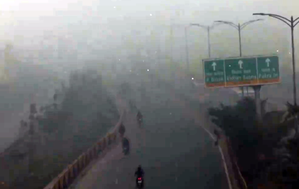Patna: The air quality in Patna and other regions of Bihar deteriorated on Friday following the bursting of firecrackers on a large scale.
Despite the Bihar State Pollution Control Board’s ban on firecrackers in four districts, fireworks were still used extensively, resulting in a sharp rise in air pollution.
The Air Quality Index (AQI) measurements, with values reaching 270 in Raja Bazar and exceeding 278 in Dak Bungalow, indicate “poor” air quality levels that pose health risks, especially to vulnerable populations like children, the elderly, and those with respiratory issues.
The primary pollutant is particulate matter (PM), with dust particles rising well above the standard safety limits. Firecrackers emit PM2.5 and PM10 particles, which are particularly harmful as they can penetrate deep into the lungs and even enter the bloodstream, exacerbating respiratory conditions and cardiovascular risks.
In addition to the direct pollutants from fireworks, the seasonal weather also traps these particles closer to the ground, worsening air quality.
The current air quality in Patna and other cities in Bihar, though not as extreme as last year, remained critically concerning. This year’s Air Quality Index (AQI) in areas like Raja Bazar and Dak Bungalow has reached hazardous levels, with PM2.5 particles rising to over three times the standard limits and PM10 particles doubling to tripling standard levels in some places.
With winter approaching, pollution levels may worsen due to lower temperatures and the phenomenon known as temperature inversion. During temperature inversions, cooler air gets trapped near the ground under a layer of warmer air, which prevents pollutants from dispersing into the atmosphere.
In areas like Patna, Muzaffarpur, Vaishali, and Gaya, such weather conditions could further concentrate pollutants closer to the ground, affecting air quality and health.
The AQI of Vaishali was 227, Muzaffarpur 201 and Gaya recorded 167.
Although the current AQI levels have not reached last year’s post-Diwali levels of over 400, likely due to clearer skies and lower fog levels, the pollution control measures need urgent reinforcement. Stronger enforcement of firecracker bans, control of vehicular emissions, and dust mitigation steps in construction areas could all play a role in managing and improving air quality.
–IANS


Comments are closed.